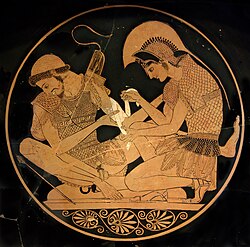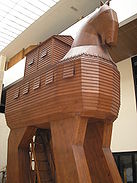
| Home | Sources Directory | News Releases | Calendar | Articles | | Contact | |
Trojan Horse

The Trojan Horse is a tale from the Trojan War, as told in Virgil's Latin epic poem The Aeneid and by Quintus of Smyrna. The events in this story from the Bronze Age took place after Homer's Iliad, and before his Odyssey. It was the stratagem that allowed the Greeks finally to enter the city of Troy and end the conflict. In one version, after a fruitless 10-year siege, the Greeks constructed a huge wooden horse, and hid a select force of 30 men inside. The Greeks pretended to sail away, and the Trojans pulled the horse into their city as a victory trophy. That night the Greek force crept out of the horse and opened the gates for the rest of the Greek army, which had sailed back under cover of night. The Greek army entered and destroyed the city of Troy, decisively ending the war.
In the Greek tradition, the horse is called î�î¿ύρî�î�î¿ς á��ππî¿ς, Doúreios Híppos, the "Wooden Horse", in the Homeric Ionic dialect.
Metaphorically a "Trojan Horse" has come to mean any trick or strategem that causes a target to invite a foe into a securely protected bastion or space. It is now often associated with "malware" computer programmes presented as useful or harmless to induce the user to install and run them.
Contents |
[edit] Legend

According to Quintus Smyrnaeus, Odysseus came up with the idea of building a great wooden horse (the horse being the emblem of Troy), hiding a select force inside, and fooling the Trojans into wheeling the horse into the city as a trophy. Under the leadership of Epeios, the Greeks built the wooden horse in three days. Odysseus' plan called for one man to remain outside of the horse; he would act as though the Greeks abandoned him, leaving the horse as a gift for the Trojans. A Greek soldier named Sinon was the only volunteer for the role. Virgil describes the actual encounter between Sinon and the Trojans: Sinon successfully convinces the Trojans that he has been left behind and that the Greeks are gone. Sinon tells the Trojans that the Horse is an offering to the goddess Athena, meant to atone for the previous desecration of her temple at Troy by the Greeks, and ensure a safe journey home for the Greek fleet. The Horse was built on such a huge size to prevent the Trojans from taking the offering into their city, and thus garnering the favor of Athena for themselves.
While questioning Sinon, the Trojan priest Laocoön guesses the plot and warns the Trojans, in Virgil's famous line "Timeo Danaos et dona ferentes" (I fear Greeks even those bearing gifts).[1] However, the god Poseidon sent two sea serpents to strangle him and his sons Antiphantes and Thymbraeus, before any Trojan believes his warning. King Priam's daughter Cassandra, the soothsayer of Troy, insists that the horse would be the downfall of the city and its royal family. She too is ignored, hence their doom and loss of the war.[2]
This incident is mentioned in the Odyssey:
- What a thing was this, too, which that mighty man wrought and endured in the carven horse, wherein all we chiefs of the Argives were sitting, bearing to the Trojans death and fate! 4.271 ff
- But come now,change thy theme, and sing of the building of the horse of wood, which Epeius made with Athena's help, the horse which once Odysseus led up into the citadel as a thing of guile, when he had filled it with the men who sacked Ilion . 8.487 ff (trans. Samuel Butler)
The most detailed and most familiar version is in Virgil's Aeneid, Book 2 (trans. John Dryden).
By destiny compell'd, and in despair,
The Greeks grew weary of the tedious war,
And by Minerva's aid a fabric rear'd,
Which like a steed of monstrous height appear'd:
The sides were plank'd with pine; they feign'd it made
For their return, and this the vow they paid.
Thus they pretend, but in the hollow side
Selected numbers of their soldiers hide:
With inward arms the dire machine they load
And iron bowels stuff the dark abode.
[...]
Laocoön, follow'd by a num'rous crowd,
Ran from the fort, and cried, from far, aloud:
'O wretched countrymen! What fury reigns?
What more than madness has possess'd your brains?
Think you the Grecians from your coasts are gone?
And are Ulysses' arts no better known?
This hollow fabric either must inclose,
Within its blind recess, our secret foes;
Or 't is an engine rais'd above the town,
T' o'erlook the walls, and then to batter down.
Somewhat is sure design' d, by fraud or force:
Trust not their presents, nor admit the horse.'
Book II includes Laocoön saying: "Equo ne credite, Teucri. Quidquid id est, timeo Danaos et dona ferentes." ("Do not trust the horse, Trojans! Whatever it is, I fear the Greeks, even bringing gifts.") This is the origin of the modern adage "Beware of Greeks bearing gifts".
[edit] Men in the horse
Thirty soldiers hid in the Trojan horse's belly and two spies in its mouth. Other sources give different numbers: Apollodorus 50;[3] Tzetzes 23;[4] and Quintus Smyrnaeus gives the names of thirty, but says there were more.[5] In late tradition the number was standardized at 40. Their names follow:[6]
- Odysseus (leader)
- Acamas
- Agapenor
- Ajax the Lesser
- Amphidamas
- Amphimachus
- Antiklos
- Antimachus
- Antiphates
- Calchas
- Cyanippus
- Demophon
- Diomedes
- Echion
- Epeius
- Eumelus
- Euryalus
- Eurydamas
- Eurymachus
- Eurypylus
- Ialmenus
- Idomeneus
- Iphidamas
- Leonteus
- Machaon
- Meges
- Menelaus
- Menestheus
- Meriones
- Neoptolemus
- Peneleus
- Philoctetes
- Podalirius
- Polypoetes
- Sthenelus
- Teucer
- Thalpius
- Thersander
- Thoas
- Thrasymedes
[edit] Factual explanations
According to Homer, Troy stood overlooking the Hellespont ' a channel of water that separates Asia Minor and Europe. In the 1870s, Heinrich Schliemann set out to find it.[7] Following Homer's description, he started to dig at Hisarlik in Turkey and uncovered the ruins of several cities, built one on top of the other. Several of the cities had been destroyed violently, but it is not clear which, if any, was Homer's Troy.
Pausanias, who lived in the 2nd century AD, wrote in his book Description of Greece "That the work of Epeius was a contrivance to make a breach in the Trojan wall is known to everybody who does not attribute utter silliness to the Phrygians"[8] where by Phrygians he means the Trojans.
There has been modern speculation that the Trojan Horse may have been a battering ram resembling, to some extent, a horse, and that the description of the use of this device was then transformed into a myth by later oral historians who were not present at the battle and were unaware of that meaning of the name. Assyrians at the time used siege machines with animal names; it is possible that the Trojan Horse was such.[citation needed]
It has also been suggested that the Trojan Horse actually represents an earthquake that occurred between the wars that could have weakened Troy's walls and left them open for attack;[9] the deity Poseidon had a triple function as a god of the sea, of horses and of earthquakes. Structural damage on Troy VI ' its location being the same as that represented in Homer's Iliad and the artifacts found there suggesting it was a place of great trade and power ' shows signs that there was indeed an earthquake. Generally, though, Troy VIIa is believed to be Homer's Troy (see below)..
[edit] Images
| This section requires expansion. |

There are three known surviving classical depictions of the Trojan horse. The earliest is on a fibula brooch dated about 700 BC. The other two are on relief pithos vases from the adjoining Grecian islands Mykonos and Tinos, both usually dated between 675 and 650 BC, the one from Mykonos being known as the Mykonos Vase.[10][11] Historian Michael Wood, however, dates the Mykonos Vase to the 8th century BC, some 500 years after the supposed time of the war, but before the written accounts attributed by tradition to Homer. Wood concludes from that evidence that the story of the Trojan Horse was in existence prior to the writing of those accounts.[12]
|
At the Schliemann Museum in Ankershagen, Germany |
From the movie Troy |
[edit] See also
- Troy (2004 movie)
- The Trojan Rabbit in Monty Python and the Holy Grail
- The Psychological Operations units of the U.S. Army carry a Trojan Horse in their logo.
- Troy: Fall of Kings, final book in the Troy Trilogy by David Gemmell
[edit] Notes
- ^ http://www.poetryintranslation.com/PITBR/Latin/VirgilAeneidII.htm#_Toc536009311
- ^ Virgil. The Aeneid. Trans. Robert Fitzgerald. New York: Everyman's Library, 1992. Print.
- ^ Epitome 5.14
- ^ Posthomerica 641'650
- ^ Posthomerica xii.314-335
- ^ http://www.maicar.com/GML/WOODENHORSE.html
- ^ Image
- ^ 1,XXIII,8
- ^ Earthquakes toppled ancient cities: 11/12/97
- ^ Sparks, B.A. (April 1971). "The Trojan Horse in Classical Art". Greece & Rome. Second series 18 (1): 54'70. http://www.jstor.org/stable/642388. Retrieved 26 October 2010.
- ^ Caskey, Miriam Ervin (Winter 1976). "Notes on Relief Pithoi of the Tenian-Boiotian Group". American Journal of Archaeology 80 (1): 19'41. http://www.jstor.org/stable/502935. Retrieved 26 October 2010.
- ^ Wood, Michael (1985). In Search of the Trojan War. London: BBC books. pp. 80; 251. ISBN 9780563201618.
[edit] External links
 Media related to Trojan horse at Wikimedia Commons
Media related to Trojan horse at Wikimedia Commons- Helen of Troy (1956) at the Internet Movie Database
- The Trojan Horse (1962) at the Internet Movie Database
- Troy (2004) at the Internet Movie Database
|
SOURCES.COM is an online portal and directory for journalists, news media, researchers and anyone seeking experts, spokespersons, and reliable information resources. Use SOURCES.COM to find experts, media contacts, news releases, background information, scientists, officials, speakers, newsmakers, spokespeople, talk show guests, story ideas, research studies, databases, universities, associations and NGOs, businesses, government spokespeople. Indexing and search applications by Ulli Diemer and Chris DeFreitas.
For information about being included in SOURCES as a expert or spokesperson see the FAQ or use the online membership form. Check here for information about becoming an affiliate. For partnerships, content and applications, and domain name opportunities contact us.





